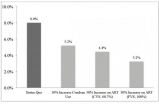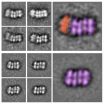Blinded by science
Trivial scientific information can increase our sense of trust in products
2014-10-15
(Press-News.org) Do you believe in science? Your faith in science may actually make you more likely to trust information that appears scientific but really doesn't tell you much. According to a new Cornell Food and Brand Lab study, published in Public Understanding of Science, trivial elements such as graphs or formulas can lead consumers to believe products are more effective. "Anything that looks scientific can make information you read a lot more convincing," says the study's lead author Aner Tal, PhD, "The scientific halo of graphs, formulas, and other trivial elements that look scientific may lead to misplaced belief."
In one study, Tal and co-author Brian Wansink, PhD (author of Slim by Design: Mindless Eating Solutions for Everyday Life ) recruited 61 individuals to read information about a new medication. Half of the participants read a paragraph about the medication and the other half read the same paragraph with an accompanying graph. The graph did not provide any new information. Afterwards participants were asked: "Does the medication really reduce illness?" Graphs helped convince almost all of the participants that the medication worked: 96.6% of those who saw the graph believed that the medication would effectively reduce illness, whereas only 67.7% of those who saw only the text believed that that it would reduce illness.
Two additional studies supported the researchers' hypotheses that individuals are influenced by "scientific looking" elements not because they help with understanding or information retention, but because "scientific looking" information is perceived as true. In the second study 56 participants were presented with either the paragraph and graph from the first study or just with the paragraph with an added sentence repeating that the medication reduced illness by 20%. Afterwards all participants were asked to estimate how much the medication reduced illness and their level of agreement with the statement: "I believe in science." Retention of information was the same for both groups - graphs did not appear to increase their understanding of the information or their recall of the percentage by which it reduced illness. Those who indicated a belief in science and who were shown the graph expressed the strongest confidence in the effectiveness of the medication. This shows that belief in science can make individuals more likely to be persuaded by trivial, "scientific looking" graphs."A general faith in science may lead people to believe things that just look scientific, but aren't," explains Tal.
In the third study the paragraph was shown to participants as in the two prior studies. This time, instead of a graph, half of the 57 participants in this study were given the chemical formula of the drug's active ingredient. Those who were shown the chemical formula believed the medication would work for 2 hours longer than those who were given its text description: 5.9 hours vs. 3.8 hours, an increase of 56.8%. These results support the idea that increased confidence was due to participants' trust in information that appears to add scientific validity.
Researchers concluded that presenting consumers with "scientific looking" information increases product confidence because individuals believe that science denotes truth. Dr. Tal cautions consumers, "What this means is that when you read claims about new products, whether it's a medication or a new technology, you should ask yourself, 'what's the actual scientific support for the claims being made?' Don't let things that look scientific but don't really tell you much fool you. Sometimes a graph is just a graph! Scrutinize what you read so that you're not blinded by what looks like science, but might not be!"
INFORMATION:
For more information see: http://foodpsychology.cornell.edu/OP/trivial_graph
[Attachments] See images for this press release:

ELSE PRESS RELEASES FROM THIS DATE:
2014-10-15
During the 1930s, North America endured the Dust Bowl, a prolonged era of dryness that withered crops and dramatically altered where the population settled. Land-based precipitation records from the years leading up to the Dust Bowl are consistent with the telltale drying-out period associated with a persistent dry weather pattern, but they can't explain why the drought was so pronounced and long-lasting.
The mystery lies in the fact that land-based precipitation tells only part of the climate story. Building accurate computer reconstructions of historical global precipitation ...
2014-10-15
Our mood can affect how we walk — slump-shouldered if we're sad, bouncing along if we're happy. Now researchers have shown it works the other way too — making people imitate a happy or sad way of walking actually affects their mood.
Subjects who were prompted to walk in a more depressed style, with less arm movement and their shoulders rolled forward, experienced worse moods than those who were induced to walk in a happier style, according to the study published in the Journal of Behavior Therapy and Experimental Psychiatry.
CIFAR Senior Fellow Nikolaus ...
2014-10-15
Rochester, Minn. – The American Academy of Neurology (AAN) and the American Association of Neuromuscular & Electrodiagnostic Medicine (AANEM) offer a new guideline on how to determine what genetic tests may best diagnose a person's subtype of limb-girdle or distal muscular dystrophy. The guideline is published in the October 14, 2014, print issue of Neurology®, the medical journal of the AAN.
Researchers reviewed all of the available studies on the muscular dystrophy, a group of genetic diseases in which muscle fibers are unusually susceptible to damage, as ...
2014-10-15
COLUMBIA, Mo. – According to the Centers for Disease Control and Prevention (CDC), many teens skip breakfast, which increases their likelihood of overeating and eventual weight gain. Statistics show that the number of adolescents struggling with obesity, which elevates the risk for chronic health problems, has quadrupled in the past three decades. Now, MU researchers have found that eating breakfast, particularly meals rich in protein, increases young adults' levels of a brain chemical associated with feelings of reward, which may reduce food cravings and overeating ...
2014-10-15
PROVIDENCE, R.I. [Brown University] — To address the HIV epidemic in Mexico is to address it among men who have sex with men (MSM), because they account for a large percentage of the country's new infections, says Omar Galárraga, assistant professor of health services policy and practice in the Brown University School of Public Health.
A major source of the new infections is Mexico City's male-to-male sex trade, Galárraga has found. In his research, including detailed interviews and testing with hundreds of male sex workers on the city's streets and in ...
2014-10-15
Coordinating product placement with advertising in the same television program can reduce audience loss over commercial breaks by 10%, according to a new study in the Articles in Advance section of Marketing Science, a journal of the Institute for Operations Research and the Management Sciences (INFORMS).
Synergy or Interference: The Effect of Product Placement on Commercial Break Audience Decline is by David A. Schweidel, Associate Professor of Marketing at Goizueta Business School, Emory University, Natasha Zhang Foutz, Assistant Professor of Marketing at McIntire School ...
2014-10-15
UPTON, NY—The proteins that drive DNA replication—the force behind cellular growth and reproduction—are some of the most complex machines on Earth. The multistep replication process involves hundreds of atomic-scale moving parts that rapidly interact and transform. Mapping that dense molecular machinery is one of the most promising and challenging frontiers in medicine and biology.
Now, scientists have pinpointed crucial steps in the beginning of the replication process, including surprising structural details about the enzyme that "unzips" and splits ...
2014-10-15
OAK RIDGE, Tenn., Oct. 15, 2014—Researchers at the Department of Energy's Oak Ridge National Laboratory have demonstrated an additive manufacturing method to control the structure and properties of metal components with precision unmatched by conventional manufacturing processes.
Ryan Dehoff, staff scientist and metal additive manufacturing lead at the Department of Energy's Manufacturing Demonstration Facility at ORNL, presented the research this week in an invited presentation at the Materials Science & Technology 2014 conference in Pittsburgh.
"We can now ...
2014-10-15
October 15, 2014 – A recently concluded demonstration project made meaningful progress toward introducing a "patient-centered medical home" approach at "safety net" practices serving vulnerable and underserved populations. Lessons learned in the course of developing and implementing the Safety Net Medical Home Initiative (SNMHI) are featured in a special November supplement to Medical Care. The journal is published by Lippincott Williams & Wilkins, a part of Wolters Kluwer Health.
The supplement presents nine original papers sharing "experience and learning" from ...
2014-10-15
AMES, Iowa – The stories are shocking and heartbreaking, but they are often disjointed and hard to follow. In severe cases, the narratives are even more chaotic. This is reality for victims of workplace bullying and a major reason why they stay silent, said Stacy Tye-Williams, an assistant professor of communications studies and English at Iowa State University.
No one expects to go to work and feel as though they are back on the school playground, but bullying is all too common for many workers. Approximately 54 million workers, or 35 percent of U.S. employees, ...
LAST 30 PRESS RELEASES:
[Press-News.org] Blinded by science
Trivial scientific information can increase our sense of trust in products




